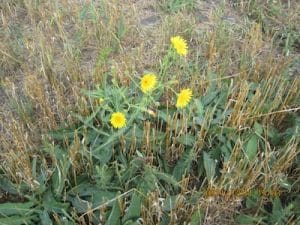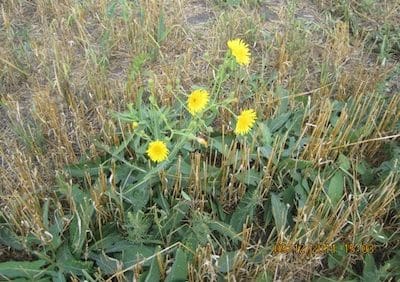Fall is a good time to control perennial and winter annual weeds. The message this week includes two reminders:
1. Wait for post-harvest regrowth. Before spraying, make sure perennial weeds are actively growing with new supple leaf area to target. Perennial weeds cut off at harvest need time to accumulate new leaf tissue that will act as suitable surfaces for absorption of herbicides applied post-harvest. (Annual weeds are usually done for the season after being cut off — unless it stays warm into November.) Even with the recommendation to wait for 4 to 6 weeks of regrowth, leaf surface area is still only a fraction of what it was prior to harvest. Therefore glyphosate rates may need to increase by 2 to 3 times to get the same concentration of glyphosate into the plant root. If frost is predicted or has occurred, avoid application until leaf condition of the target weeds can be evaluated.
2. Know the best timing for the weeds present:
Perennials such as dandelions are best controlled in September, especially when using glyphosate or Group-2 products. Wait at least a month after cutting for adequate leaf area regrowth so the herbicide has a target, but at the same time, the later you get into fall the higher the risk of losing healthy leaf tissue to frost. Without healthy leaf tissue, the herbicide can’t get translocation to the weed’s crown and storage roots where the killing can occur. Even with good regrowth, the leaf area to target is not as great as prior to harvest, so glyphosate rates need to be proportionally higher to get the same amount into the plant. In any case with perennials, as long as leaf condition is good and temperatures are warm, fall is a good time to spray them.

October is usually the best time to control winter annuals such as narrow-leaved hawk’s-beard, stork’s-bill, annual sow thistle (common and spiny) and cleavers. That way you get all that have emerged. But check weed staging. Many of the post harvest product labels have weed staging listed, and winter annuals can hit those stages before October. Apply herbicide when the majority of winter annuals have emerged and are at the right stage for control. With winter annuals, the goal is to break winter dormancy (which you can do with a Group 4 herbicide) or killing new buds being laid down for next year (which you can do with glyphosate).
Further reading:
Fall weed control on fields planned for canola
Fall weed control and frost
Foxtail barley and fall weed control
Top 10 considerations to prep for next year
Weed management before and after harvest

